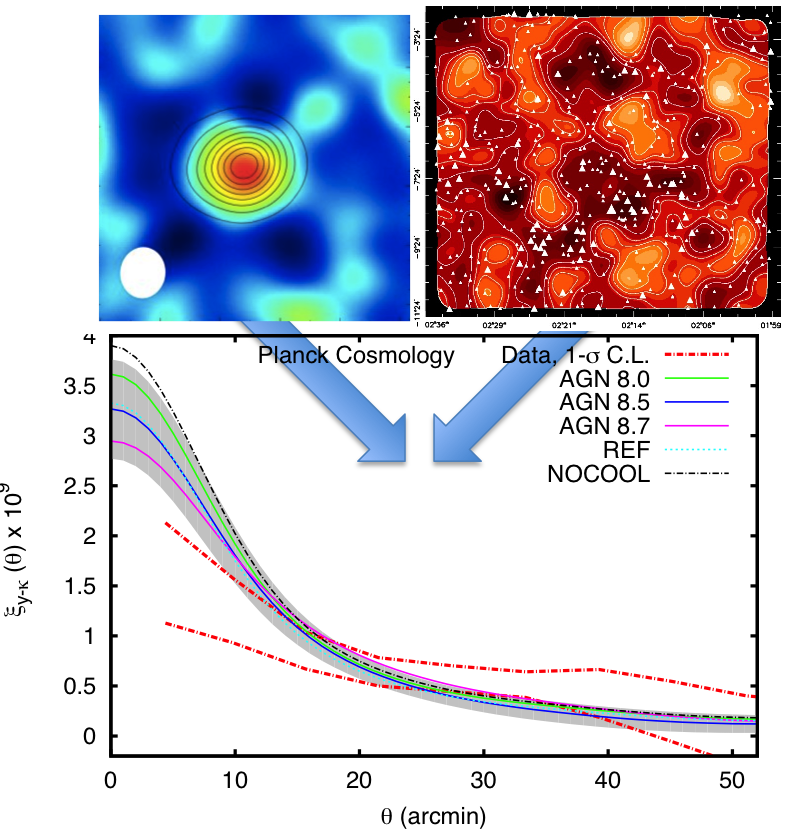I am interested in topics related to weak lensing, baryonic physics, large scale structure formation, dark energy and modified gravity and strong lensing cosmology.
Weak Gravitational Lensing
As a member of the ongoing Weak Lensing experiments, Red Sequence Cluster Survey Lensing (RCSLenS) and Kilo Degree survey (KiDS) , I am working on higher order statistics of the lensing data, feasible by this generation of surveys.Combining it with hydrodynamical simulations, extra information about dark matter distribution and AGN feedback can be extracted.
Baryonic physics and AGN feedback
Only about 10% of all the baryons in the Universe reside in stars and cold gas in galaxies while the rest is thought to reside in a diffuse gas component spread over a wide range of scales, densities and temperatures. Observing this component is difficult and is presently limited to regions where the gas is hot and dense, where it can be be detected via X-ray emission and/or the thermal Sunyaev-Zeldovich (tSZ) effect.
Current observations are limited by sensitivity and/or angular resolution, and by confusion from Galactic and extragalactic dust emission. However, the cross-correlation of tSZ signal as a probe of baryons with gravitational lensing allows us to selectively probe gas at regions with lower baryon pressure, and to directly compare the relationship between gas and mass.
We combine observations with theoretical halo model predictions and cosmological hydrodynamical simulations, which includes different galactic feedback models, to understand the evolution and distribution of baryons in galaxies and galaxy clusters.
Related publications:
Probing the diffuse baryon distribution with the lensing-tSZ cross-correlation

Dark Energy and Modified Gravity
The acceleration of the expansion of the Universe has not yet received a convincing explanation. In the last fifteen years, it has been suggested that its origin could be linked to deep issues in physics. A non-vanishing cosmological constant, which could be linked to the vacuum energy of particle physics, is still the most common and the simplest possibility. The cosmological constant could be embedded in a larger class of models, dark energy, where dynamics dictate the value of the vacuum energy.
Another explanation could be provided by a modification of the laws of gravity on large scales. It has been realised in the last few years that modified gravity models always involve a scalar degree of freedom whose origin springs from the existence of a scalar polarisation for a massive graviton. In these models, the scalar degree of freedom can lead to dynamical dark energy when the range of the modified gravity interaction is cosmological, and the theory describing the behaviour of the scalar field involves conformal and disformal couplings to matter. As a result, scalar- tensor models with couplings to matter represent a well-motivated and versatile class of dark energy.
With collaborators, I have developed a phenomenological formalism for studying the linear growth of structure through well-defined parametrization of modifications to ΛCDM prediction (MG functions). For this analysis, I have developed the MGCAMB code (and accompanying MGcosmoMC and CosmoFish) that calculates observables from MG models, parametrized with MG functions.
Related publications:
Testing gravity with CAMB and CosmoMC

Strong Lensing Cosmology
Strong gravitational lensing of time variable sources such as quasars and supernovae creates observable time delays between the multiple images. Current and next generation surveys will find hundreds to thousands of lensed systems but accurate time delay estimation from noisy, gappy lightcurves is potentially a limiting systematic. While, time delays can provide a powerful cosmographic probe through the "time delay distance", lightcurves of lensed images have measurement gaps, noise, systematics such as microlensing from substructure along an image line of sight, and no a priori functional model, making robust time delay estimation challenging.
Combining Gaussian Process crosscorrelation technique, machine learning selection methods, and using a large sample of blinded lightcurves from the Strong Lens Time Delay Challenge , we can delivers an average bias within 0.1% depending, necessary for subpercent Hubble constant determination, and sub-percent accuracy in measureing the time delays. We study the effects of survey characteristics such as cadence, season, and campaign length, and derive requirements for time delay cosmology.
Related publications:
Robust Strong Lensing Time Delay Estimation
Next Generation Strong Lensing Time Delay Estimation with Gaussian Processes
Strong Lens Time Delay Challenge: I. Experimental Design
Strong Lens Time Delay Challenge: II. Results of TDC1

